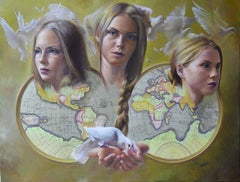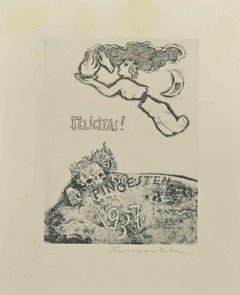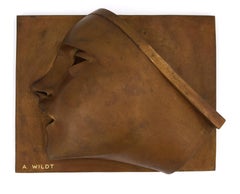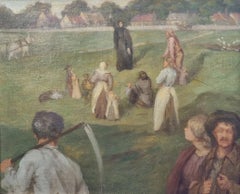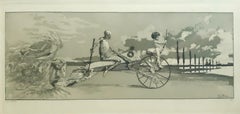Symbolist Art
to
165
572
103
158
45
74
Overall Width
to
Overall Height
to
2
108
641
204
27
103
111
93
13
12
24
18
49
15
114,425
65,050
54,899
27,066
14,956
9,341
6,503
5,768
4,192
3,054
2,593
2,327
2,253
723
604
265
65
566
355
233
182
181
109
101
58
48
48
46
38
33
32
26
25
21
20
20
19
258
225
161
159
135
95
44
38
37
34
132
433
547
249
Style: Symbolist
“The Kindly ones ”, Triple Portrait World Map Doves Symbolist Oil Painting
By Andrée Bars
Located in Clermont-Ferrand, Auvergne-Rhône-Alpes
Titled "The kindly ones" and by Andrée Bars, this oil painting on canvas captures a striking combination of realism and fantasy, depicting three female faces gracefully positioned against a serene background. Each face is distinct, offering a different perspective and expression, perhaps symbolizing various facets of human emotion or thought. Behind them, a beautifully detailed world map stretches across a globe, emphasizing themes of global connection and exploration. The atmosphere is further enriched by the ethereal presence of white doves, which are universally recognized symbols of peace. These elements coalesce into a surreal yet harmonious composition that invites viewers to ponder the deeper connections between humanity and the world at large. The overall effect is both captivating and thought-provoking, showcasing the artist's skill in blending the real with the symbolic to evoke introspection and wonder.
Andrée Bars is a French painter. Having been strictly trained for 4 years by the American hyper-realist painter Mr. Ted Seth Jacobs, who himself inherited 19th century masters’ skills from his own professor, Andrée Bars learned the profession of painting in its purest tradition. She still applies these ancient masters...
Category
2010s Symbolist Art
Materials
Oil
Ex Libris - Felicitas! - Etching by Michel Fingesten - 1937
Located in Roma, IT
Ex Libris - Felicitas is an Etching print created by Michel Fingesten in 1937.
Hand Signed on the lower right margin.
Good conditions.
Michel Fingesten (1884 - 1943) was a Czec...
Category
1930s Symbolist Art
Materials
Etching
Victory - Bronze Sculpture After A. Wildt - 1990
By Adolfo Wildt
Located in Roma, IT
Second Edition of 6 copies plus 3 Artist’s Proofs, realized in 1990 after the famous homonymous sculpture realized by Wildt in 1918/19. Authorized by Wildt's heirs, from the original...
Category
1990s Symbolist Art
Materials
Bronze
Symbolist British Painting Prophet woman Peasants Art nouveau 20th
Located in PARIS, FR
ROBERTSON
20th
Oil on canvas
60 x 73 cm (69 x 82 cm with frame)
Signed and dated lower left "RBTSN / 1909"
Very good condition
Beautiful black frame with black edging
This symbolist...
Category
Early 1900s Symbolist Art
Materials
Oil
$1,669 Sale Price
20% Off
Amor, Tod und Jenseits - Etching by M. Klinger - 1881
By Max Klinger
Located in Roma, IT
Amor, Tod und Jenseits, (Cupid, death and afterlife) is an original etching and aquatint on paper Chine collé, realized by Max Klinger in 1881, plate XII from “Intermezzi” Opus IV,...
Category
1880s Symbolist Art
Materials
Etching, Aquatint
Elegant Women in a Park - Original lithograph, 1898
By Manuel Robbe
Located in Paris, IDF
Manuel ROBBE
Elegant Women in a Park, 1898
Original lithograph (Champenois workshop)
Printed signature in the plate
On vellum, 40 x 31 cm (c. 16 x 12 in)
INFORMATION: Lithograph cr...
Category
1890s Symbolist Art
Materials
Lithograph
Melancolic Seascape with Sailboats - Original Lithograph, 1898
Located in Paris, IDF
Francis JOURDAIN
Melancolic Seascape with Sailboats, 1898
Original lithograph (Champenois workshop)
Printed signature in the plate
On vellum, 40 x 31 cm (c. 16 x 12 in)
INFORMATION...
Category
1890s Symbolist Art
Materials
Lithograph
Candeur (Oil Painting, Symbolist, Portrait, Rose, Crane, Orchid)
Located in Kansas City, MO
Stella Jae
Candeur
2024
Oil on canvas
Size: 23.62 x 31.49 inches (60 x 80 cm)
Signed by hand
COA provided
Stella J Richey is an international visual artist and designer.Her works in...
Category
2010s Symbolist Art
Materials
Canvas, Oil
$1,444 Sale Price
46% Off
Le Sire De Lumey
Located in Middletown, NY
Brussels: J. Bouwens, 1867. Etching with aquatint and engraving on laid Japan paper, 9 3/4 x 6 1/2 inches (247 x 163 mm), full margins. Fifth state (of 5). Scattered moderate foxing....
Category
Late 19th Century Symbolist Art
Materials
Laid Paper, Engraving, Etching, Aquatint
Menashe Kadishman, Sheep head 35, Acrylic on canvas
Located in Tel Aviv, IL
Menashe Kadishman, Sheep head, Symbolist painting, colored painting, Israeli art, Israeli art
Category
1980s Symbolist Art
Materials
Acrylic
La Création de l'Homme, Bible.
By Marc Chagall
Located in OPOLE, PL
Marc Chagall (1887-1985) - La Création de l'Homme
Etching from 1958.
Edition of 40/100.
Signed ‘M. Ch.’ (as issued)
Enhanced with watercolour by the artist.
Dimensions of work: ...
Category
1950s Symbolist Art
Materials
Watercolor, Etching
$4,924 Sale Price
30% Off
Opus IV, Simplicius in der Waldeinode - Etching by Max Klinger - 1881
By Max Klinger
Located in Roma, IT
Opus IV, Simplicius in der Waldeinode (Simplicius in the Wilderness) belongs to a series of prints called Intermezzi realized by Max Klinger, published by Nurnberg: Stroefer, 1881.
...
Category
1880s Symbolist Art
Materials
Etching
$1,073 Sale Price
25% Off
"The Tides", Blue and Gold Symbolist Original Oil Painting
By Andrée Bars
Located in Clermont-Ferrand, Auvergne-Rhône-Alpes
"The Tides", is a symbolist oil painting on canvas by Andrée Bars.
In this composition at once cosmic and contemplative, the artist explores the invisible motion that connects time...
Category
2010s Symbolist Art
Materials
Oil
Bowl of Fruits by Fernand Blondin - Oil on Canvas - 55x46 cm
Located in Geneva, CH
Fernand Blondin (1887-1967) was a Swiss painter and teacher, celebrated for his depictions of idyllic rural life, interiors, female nudes, portraits, still-lifes, religious subjects ...
Category
Mid-20th Century Symbolist Art
Materials
Canvas, Oil
Young Girl with an Orange - Original lithograph, 1898
Located in Paris, IDF
Louise BRESLAU
Young Girl with an Orange, 1898
Original lithograph (Champenois workshop)
Printed signature in the plate
On vellum, 40 x 31 cm (c. 16 x 12 in)
INFORMATION: Lithograp...
Category
1890s Symbolist Art
Materials
Lithograph
Young Girl Playing in the Woods - Original lithograph, 1898
Located in Paris, IDF
Eugene DELATRE
Young Girl Playing in the Woods, 1898
Original lithograph (Champenois workshop)
Printed signature in the plate
On vellum, 40 x 31 cm (c. 16 x 12 in)
INFORMATION: Lit...
Category
1890s Symbolist Art
Materials
Lithograph
Frederick Cayley Robinson - A Summer Evening - British oil on paper
Located in London, GB
FREDERICK CAYLEY ROBINSON, ARA, RWS
(1862-1927)
A Summer Evening
Signed l.r.: CAYLEY-ROBINSON; inscribed on the reverse: A Summer Evening/Exhibited at Leicester Galleries
Oil on paper
16.5 by 18.5 cm., 6 ½ by 7 ¼ in.
(frame size 38.5 by 40 cm., 15 ¼ by 15 ¾ in.)
Exhibited:
London, Leicester Galleries, Small Paintings and Sketches by the Late F. Cayley Robinson, ARA, RWS, December 1929
Born in Brentford-on-Thames, the son of a stockbroker, Robinson began his artistic training at the St John’s Wood...
Category
Early 1900s Symbolist Art
Materials
Oil
Pursued Centaur (Verfolgter Centaur) - Etching by Max Klinger - 1881
By Max Klinger
Located in Roma, IT
Pursued Centaur (Verfolgter Centaur) belongs to a series of prints called Intermezzi realized by Max Klinger, published by Nurnberg: Stroefer, 1881.
Etching on paper.
Signed in the...
Category
1880s Symbolist Art
Materials
Etching
Fallen Rider - Etching by Max Klinger - 1881
By Max Klinger
Located in Roma, IT
Fallen Rider is a modern artwork realized by Max Klinger in 1881.
The artwork belongs to a series of prints called Intermezzi realized by Max Klinger, published by Nurnberg: Stroef...
Category
1880s Symbolist Art
Materials
Etching
$1,073 Sale Price
25% Off
Ex Libris Mantero - Etching by Michel Fingesten - 1930s
Located in Roma, IT
Ex Libris - Mantero is an Etching print created by Michel Fingesten.
Hand Signed on the right margin. Numbered on the left corner ex. 40/50.
The work is glued on cardboard.
Tota...
Category
1930s Symbolist Art
Materials
Etching
Rene Lynch, Day is Done, 2016, Oil on canvas, 18 x 18 x 1 in, Symbolist
By Rene Lynch
Located in Darien, CT
Born: Decatur, IL.
Lives & Works in Brooklyn, NY.
Her work has been widely exhibited nationally and internationally, including several solo exhibitions in Germany in Munich, Cologne and Berlin with Galerie Kaysser, in NYC and San Francisco with Jenkins Johnson Gallery and Tokyo and Osaka, Japan and NYC with HPGRP Gallery. Additional NYC solos include Bond Gallery, 490 Gallery, BOE, and MBM Gallery, and a large scale public art piece at One Main Window in Dumbo, Brooklyn. She has also presented major works at Kenise Barnes Fine Art, DFN Gallery, Lesley Heller Workspace, many years at “Take Home a Nude” for The New York Academy at Sotheby’s and numerous art fairs, and university galleries.
Recent museum exhibitions include a solo at Kunstlade Museum, Zittau, Germany, The Hunterdon Museum in Clifton, NJ twice. as a featured artist in Munich at the Haus der Kunst Contemporary Art Institute. PS1 Museum of Modern Art, NYC, The Kotonah Museum of Art, NY, The Virginia Museum of Fine Art, and Shore Institute of Contemporary Art, Long Branch, NJ. She currently has a painting in the exhibition Beyond Suffrage at The Museum of the City of New York.
Lynch’s work has been featured and written about in numerous publications including The New York Times, The Boston Globe, Art and Antiques magazine, American Art Collector magazine, German Bunte magazine, Oxford American magazine, and NY Arts magazine among many other publications. Rene Lynch has had several catalogues published about her work. Her art is featured on the cover of Boulevard Magazine Spring 2018. Her paintings were recently featured in scenes with Richard Gere in the film Norman.
Her work can be found in numerous private and public collections throughout the United States, Germany, France, Switzerland, Italy, Austria, Turkey, Russia and Japan.
Rene Lynch studied painting and art history at Virginia Commonwealth University, The Business of Art, Curatorial Studies Program, New York University, and Printmaking, Manhattan Graphics Center.
Lynch has been awarded several fellowships, including; two fellowships from P.S.1 Museum of Modern Art, NYC, four fellowships from The Virginia Center for the Creative Arts, and two fellowships from Oberpfalzer Kunstlerhaus, Germany, and AIR Ruhpolding, Germany, also The Manhattan Graphic Center for printmaking, and the Millay Colony, NY and twice from Soaring Gardens, PA, and Palenville InterArts, NY among others.
She has been invited to give Artists Talks at the Brooklyn Museum, NY, the Aldrich Museum, CT, the Hunterdon Museum, NJ, the Kunstlade Museum, Germany, Sotheby's Auction House, NY, Chelsea Art Museum, NY, Abrons Art Center, NY, New York Foundation for the Arts, New York Academy of Art, NY, Lumine, Tokyo, Japan, Umeda Gallery, Osaka, Japan, Jenkins Johnson Gallery, NYC, Kenise Barnes Gallery, NY, Pratt Institute, NY, Red Dot Art Fair, NY, Metaphor Contemporary Art , NY, Tribeca Arts Center, Manhattan Community College, Marymount Manhattan College, Kutztown University, PA, Simmons College, MA, LIU, Brooklyn, NY
Lynch is co-founder/director/curator of Metaphor Contemporary Art with Julian Jackson. Since 2001, they have presented over 90 solo and group exhibitions of new works by hundreds of artists at their Brooklyn, NY gallery, and at several international art fairs, placed numerous works in private and public collections including US Embassies, banks, hotels and hospitals, published several exhibition catalogs, and presented numerous artists’ and critics’ talks and panel discussions. In 2017 Lynch & Jackson co-curated with HPGRP the NY Art Lab with 35 artists in Osaka, Japan and curated and produced recent art auction benefits, involving hundreds of artist: ArtHillary art auction at Kathryn Markel Fine Arts, NYC, 2016, White Hawk...
Category
2010s Symbolist Art
Materials
Canvas, Oil
Dramatic Storm over Sandhamn, Sweden, 1943
Located in Stockholm, SE
This striking seascape, painted in 1943 by Jacob Löfgren, most likely depicts a view from Sandhamn, a location he frequently captured in his works. Four years earlier, he created ano...
Category
1940s Symbolist Art
Materials
Oil, Board
$4,197 Sale Price
20% Off
Ex Libris - Etching by Michel Fingesten - 1930s
Located in Roma, IT
"Ex Libris" is an Etching, Ex Libris, on ivory-colorated paper by Michel Fingesten .
In excellent conditions: As good as new.
This artwork represents an invitation from the artist...
Category
1930s Symbolist Art
Materials
Etching
Forellenweiher - Etching and Drypoint by Franz Von Stuck - 1890s
Located in Roma, IT
Forellenweiher is a wonderful black and white etching and drypoint on wide rod cream paper realized by Franz von Stuck in 1890-1891.
Hand signed in gr...
Category
1890s Symbolist Art
Materials
Paper, Drypoint, Etching
Scissors. 1995. Paper, etching. 41.5x59 cm
Located in Riga, LV
Nele Zirnite (1959)
2003 Associate Professor, Art Department, the Latvian Christian Academy
2000 M.F.A., the Latvian Art Academy
1995 – 2003 Lecturer, Graphic Arts Department...
Category
1990s Symbolist Art
Materials
Paper, Etching
Pegase Captif - after Odilon Redon - 1923
By Odilon Redon
Located in Roma, IT
Pegase Captif is a prototype reproduction realized after Odilon Redon.
They belong to the suite "Odilon Redon Peintre, Dessinateur et Graveur", published by Henri Felury in 1923.
...
Category
1920s Symbolist Art
Materials
Photogravure
Porioheresis. 2004. Paper, etching, 49.5x51.5 cm
Located in Riga, LV
Nele Zirnite (1959)
2003 Associate Professor, Art Department, the Latvian Christian Academy
2000 M.F.A., the Latvian Art Academy
1995 – 2003 Lecturer, Graphic Arts Department...
Category
Early 2000s Symbolist Art
Materials
Paper, Etching
Change. Paper, etching, 39.5x59 cm
Located in Riga, LV
Nele Zirnite (1959)
2003 Associate Professor, Art Department, the Latvian Christian Academy
2000 M.F.A., the Latvian Art Academy
1995 – 2003 Lecturer, Graphic Arts Department...
Category
Early 2000s Symbolist Art
Materials
Paper, Etching
Bear and Elf from "Intermezzi" - Etching by Max Klinger - 1881
By Max Klinger
Located in Roma, IT
Bear And Elf from "Intermezzi" is a print realized by Max Klinger in 1881.
Signature and number of the print on plate.
Black and white etching and aquatint. Original title: Bär und...
Category
1880s Symbolist Art
Materials
Etching
$1,252 Sale Price
25% Off
Musik und Danz (Music and Dance), after Eduard Veith, German antique engraving
By Eduard Veith
Located in Melbourne, Victoria
'Musik und Danz'
(Music and Dance)
German wood-engraving, circa 1895.
Central vertical fold as issued.
Eduard Veith was an Austrian portrait painter and stage designer. Many o...
Category
1890s Symbolist Art
Materials
Engraving
"Ascension of Light"
Located in Edinburgh, GB
“Ascension of Light” reveals the path of the soul striving for higher enlightenment and union with the divine source. The central golden circle represents the core of the universe — ...
Category
21st Century and Contemporary Symbolist Art
Materials
Gold Leaf
"Dance of Eternity"
Located in Edinburgh, GB
In “Dance of Eternity,” I sought to express the philosophical concept of the eternal cycle of life, where death and elemental forces exist in harmonious balance. The golden skulls in...
Category
21st Century and Contemporary Symbolist Art
Materials
Gold Leaf
"Eye of infinity"
Located in Edinburgh, GB
Here I depict the eye as a sign of inner vision — the capacity that perceives not outer forms but the deeper movement of the world. The hexagonal field around it serves as a model of...
Category
21st Century and Contemporary Symbolist Art
Materials
Gold Leaf
Living Caryatids - Oil Painting by Marco Rossati - 1985 ca.
By Marco Rossati
Located in Roma, IT
Beautiful and impressive painting by Marco Rossati, showing his interest for Classicism as well as for esotericism.
Through a fine painting technique Rossati retrieves the values of ...
Category
1980s Symbolist Art
Materials
Oil
Sire Halewyn - Original Etching, Drypoint and Color Pencil by F. Khnopff - 1893
Located in Roma, IT
Sire Halewyn is an original drypoint and color pencil on Japanese paper, realized by Fernand Khnopff in 1893, hand-signed and titled.
In very good conditions.
Fernand Khnopff's ...
Category
1890s Symbolist Art
Materials
Drypoint, Etching
Untitled (Mother and Child)
Located in Myrtle Beach, SC
Maurice Denis, Untitled (Mother and Child), lithograph, 1897, edition not stated. Signed in the stone, lower right. Annotated in linotype 'MAURICE DENIS, ORIGINAL LITHOGRAPHIE PAN III' in the lower left sheet corner. A fine, atmospheric impression, in warm, dark gray ink, on buff wove paper, with full margins (2 1/2 to 1 3/4 inches); a small discoloration in the bottom left sheet corner, otherwise in good condition. Image size 8 5/8 x 6 7/8 inches; sheet size 13 7/8 x 10 5/8 inches. As published in 'Pan', the leading German magazine of the period devoted to art and literature. Matted to museum standards, unframed.
Collection: Los Angeles County Museum of Art.
Reproduced: German Expressionist Prints...
Category
1890s Symbolist Art
Materials
Lithograph
Menashe Kadishman, Sheep head with crown, Acrylic on canvas
Located in Tel Aviv, IL
Menashe Kadishman, Sheep head, Symbolist painting, colored painting, Israeli art, Israeli art
Category
1980s Symbolist Art
Materials
Acrylic
"the Painter's Eye", Violin, Blue Flower and Brush, Symbolist Oil Painting
By Andrée Bars
Located in Clermont-Ferrand, Auvergne-Rhône-Alpes
In the painter's eyes, painting is an anthem of elegance and of beauty, as music. This artwork is a symbolist oil painting by Andrée Bars.
Andrée Bars is a French painter. Having been strictly trained for 4 years by the American hyper-realist painter Mr. Ted Seth Jacobs, who himself inherited 19th century masters’ skills from his own professor, Andrée Bars learned the profession of painting in its purest tradition. She still applies these ancient masters...
Category
2010s Symbolist Art
Materials
Canvas, Oil
'Le Paradis Terrestre' (Paradise on Earth) — French Symbolism
Located in Myrtle Beach, SC
Edouard Goerg, 'Le Paradis Terrestre' (Paradise on Earth), etching, 1931, edition 40. Signed, titled, and numbered '3/40' in pencil. A fine richly-inked impression, on heavy, cream w...
Category
1930s Symbolist Art
Materials
Etching
Illustration from the series "Les Fleurs du mal" - Etching After O. Redon
By Odilon Redon
Located in Roma, IT
Monogram of the artist on plate. Edition of 150 copies. One of the 50 H.C.copies in Roman Numerals. This print is one of the illustrations realized by Odilon Redon for an important e...
Category
1920s Symbolist Art
Materials
Etching
Exhibit I, paper/etching, 72/99, 5.4x5 cm, 1989
Located in Riga, LV
Exhibit I, paper/etching, 72/99, 5.4x5 cm, 1989
Category
1980s Symbolist Art
Materials
Paper, Etching
Ex Libris de Francisco Camp Rodon Valer - Woodcut Print - Mid-20th Century
Located in Roma, IT
Ex Libris de Francisco Camp Rodon Valer is an Artwork, woodcut print on ivory-colored paper. The work is glued on cardboard.
Total dimensions: 20.5 x 15 cm.
The artwork represents...
Category
1950s Symbolist Art
Materials
Woodcut
Der Zeichner - Etching by Unknown Artist of circle of Max Klinger
Located in Roma, IT
Der Zeichner is a superb etching made around 1900 by a still unknown author, but surely from the circle of Max Klinger (Leipzig, 1857 - Grossjena, 1920).
Title on plate in the lower margin in the center. Posthumous impression of a matrix by an unknown author.
The style refers to the Griffelkunst and the prescriptions of the Max Klinger "school of stylus"and of the artists who were close to him. In particular, for the subject in question, in the circle of Max Klinger, Saschia Schneider stands out, who placed male...
Category
Early 1900s Symbolist Art
Materials
Etching
Confubulation of the Transferred Libido, paper/etching, 22 x 24 cm
Located in Riga, LV
Confubulation of the Transferred Libido, paper/etching, 22 x 24 cm
Category
1980s Symbolist Art
Materials
Paper, Etching
D-156-144, monotype, cardboard/canvas/author's technique, 64x50 cm
Located in Riga, LV
D-156-144, monotype, cardboard/canvas/author's technique, 64x50 cm
Category
1980s Symbolist Art
Materials
Canvas, Paper, Pastel, Acrylic
Abel Pann Israeli Bezalel School Lithograph Judaica Biblical Print Jewish Art
By Abel Pann
Located in Surfside, FL
Abel Pann (1883–1963) was a European Jewish painter who settled in the Talpiot neighborhood of Jerusalem in the early twentieth century and taught at the Bezalel Academy of Art under...
Category
Mid-20th Century Symbolist Art
Materials
Lithograph
He gave him Two Tables of the Testimonie, even tables of stone... - The Exodus
By Marc Chagall
Located in OPOLE, PL
This work will be exhibited at Art on Paper NYC, September 4–7, 2025.
–
Marc Chagall (1887-1985) - He gave him Two Tables of the Testimonie, even tables of stone, written with the ...
Category
1960s Symbolist Art
Materials
Lithograph
$3,756 Sale Price
30% Off
Ex Libris - Marcel Jonckheere - Woodcut by Gerard Schelpe - 1959s
Located in Roma, IT
Ex Libris - Marcel Jonckheere is a Modern Artwork realized by Gerard Schelpe (1906-1973) in 1959..
Ex Libris. B/W woodcut on paper. Monogrammed on plate and dated on the back...
Category
1950s Symbolist Art
Materials
Woodcut
$114 Sale Price
40% Off
"Impact" abstract acrylic paint on linen panel 100x100cm 2021
Located in Saint Pol de Léon, Bretagne
"Impact" abstract acrylic paint and marbel powder on linen panel 100x100cm 2021
Work on the impact of elements on urban structures and organisation.
I endeavored to give thickness t...
Category
2010s Symbolist Art
Materials
Marble
Akinesia paper/etching, 14x18 cm, 1989
Located in Riga, LV
Akinesia
paper/etching, 14x18 cm, 1989
Category
1980s Symbolist Art
Materials
Paper, Etching
"La Pacha Mama", Ochre Golden Yellow Beige Symboliste Original Oil Painting
By Andrée Bars
Located in Clermont-Ferrand, Auvergne-Rhône-Alpes
“La Pacha Mama” is an original oil painting on linen by Andrée Bars.
Bathed in warm ochre, golden yellow, and soft beige tones, set against a starless blue background, this intimate...
Category
2010s Symbolist Art
Materials
Oil
VAN DEN BUSSCHE large decorative painting 20th oil canvas Fantastic landscape
By Jacques Van Den Bussche
Located in PARIS, FR
Jacques VAN DEN BUSSCHE Marseille, 1925 - 2001 Oil on canvas signed lower right 135 cm x 200 cm Signed lower right Framed Excellent condition
Jacques Van den Bussche is a painter from Marseille. He studied at the School of Fine Arts in Marseille in 1943 and then at the National School of Fine Arts in Paris in 1945. He exhibited in Paris at the Jean-Claude Bellier Gallery with, in particular, Philippe Cara Costea, Jack Chambrin, Georges Feher...
Category
20th Century Symbolist Art
Materials
Oil
Suzanne Benton, Heavenly Kingdom, 2022, oil on Belle Art primed panel, Transcend
Located in Darien, CT
In this ninth decade of life, and as a working artist for nearly70 years, Suzanne Benton has become interested in the concept of Late Style as described by the literary theorist Edwa...
Category
2010s Symbolist Art
Materials
Oil
Das Grosse Tier II - Etching by Richard Muller - 1919
Located in Roma, IT
Das Grosse Tier II is an original etching and drypoint, realized by Richard Müller in 1919, signed on the plate, numbered 60/74 and signed in pencil l...
Category
1910s Symbolist Art
Materials
Etching
Andra Samelson, Jalü #1, archival pigment print, Ed. 4/5, Rainbow reflections
Located in Darien, CT
Rainbow Light can manifest anywhere and anytime, representing ominscience and it can dissolve instantly, representing impermanence. It is without shadow and represents awareness with...
Category
2010s Symbolist Art
Materials
Archival Pigment
Ballerinas - Photolithograph after C. Guys - Early 20th Century
Located in Roma, IT
Ballerinas is a photolithograph print on ivory-colored paper, glued on a greenish Passepartout realized in the early 20 century After Constantin Guys
Good conditions.
The artwork ...
Category
Early 20th Century Symbolist Art
Materials
Lithograph
$200 Sale Price
30% Off
"War and Peace", Silent Requiem Broken Stone and Doves Original Oil Painting
By Andrée Bars
Located in Clermont-Ferrand, Auvergne-Rhône-Alpes
“War and Peace” is an original oil painting on linen by Andrée Bars.
In warm sandstone tones, ranging from ochre beige to dusty brown, this powerful composition stages a moment of t...
Category
2010s Symbolist Art
Materials
Oil
Abel Pann Israeli Bezalel School Lithograph Judaica Biblical Print Jewish Art
By Abel Pann
Located in Surfside, FL
Abel Pann (1883–1963) was a European Jewish painter who settled in the Talpiot neighborhood of Jerusalem in the early twentieth century and taught at the Bezalel Academy of Art under...
Category
Mid-20th Century Symbolist Art
Materials
Lithograph
Royalties
Located in Kansas City, MO
Stella Jae
Royalties
2023
Oil on Canvas
Size: 23.62 x 34.49 inches (60 x 80cm)
Signed by hand
COA provided
Ref.: 924802-2114
----------
Tags: #StellaJRich...
Category
2010s Symbolist Art
Materials
Canvas, Oil
Helping Conundrum
By Airom
Located in Santa Monica, CA
Enigmatic oil painting by self-taught artist Airom
Includes some elements of canvas pasted to the canvas for 3D texture.
Orange under-painting underneath neutral outer layers
Category
21st Century and Contemporary Symbolist Art
Materials
India Ink, Oil
$720 Sale Price
60% Off
Symbolist art for sale on 1stDibs.
Find a wide variety of authentic Symbolist art available for sale on 1stDibs. Works in this style were very popular during the 21st Century and Contemporary, but contemporary artists have continued to produce works inspired by this movement. If you’re looking to add art created in this style to introduce contrast in an otherwise neutral space in your home, the works available on 1stDibs include elements of orange, blue, green, red and other colors. Many Pop art paintings were created by popular artists on 1stDibs, including Michel Fingesten, Abel Pann, Franz von Bayros (Choisi Le Conin), and Ferdinand Hodler & R. Piper & Co.. Frequently made by artists working with Paint, and Oil Paint and other materials, all of these pieces for sale are unique and have attracted attention over the years. Not every interior allows for large Symbolist art, so small editions measuring 1.58 inches across are also available. Prices for art made by famous or emerging artists can differ depending on medium, time period and other attributes. On 1stDibs, the price for these items starts at $55 and tops out at $378,675, while the average work sells for $863.
Still Thinking About These?
All Recently ViewedMore Ways To Browse
Mauritz Lindstrom
Maximillien Luce
Michael Budden Central Park
Midcentury Matador Paintings
Mike Wright
Miracle On Ice
Mississippi River Painting
Monarch Of The Glen Painting
Moroccan Paintings Essaouira
Morpho Butterfly Art
Mount Tamalpais
Murray Dessner
Native American Oklahoma
New England Barn
New Orleans Jazz Poster
Niagara Falls Oil
Oil Painting By Alice
Oil Painting Willow Tree
